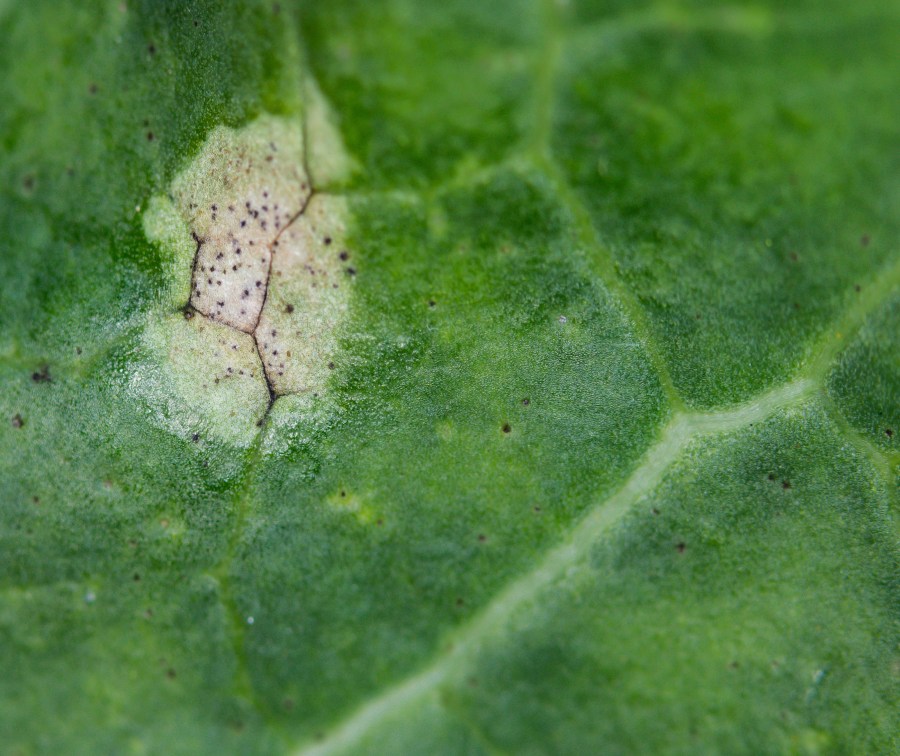Research investigating phoma stem canker in oilseed rape indicates the pathogen continues to mutate, posing a potential threat to the efficacy of fungicides particularly azoles. CPM investigates what this could mean for growers.
“Two ‘sibling’ pathogen species have taken very different evolutionary routes to overcoming chemistry.” DR KEVIN KING
By Janine Adamson
The fungal species which cause phoma leaf spot and stem canker in oilseed rape are undergoing an evolutionary journey according to scientists, however, they’re taking two very different routes in their quest to become less sensitive to chemical controls.
Phoma, a disease which damages brassica crops including OSR, is caused by two related pathogens: Plenodomus lingam and P. biglobosus. Conventionally, azole-based chemistry has been a go-to solution for combatting incidences of phoma across Europe.
The target of azoles is the CYP51 protein – an enzyme required for biosynthesis of sterols which are required for fungal cell membrane integrity.
However, as well as decreased azole sensitivity already having emerged in Australian and eastern European P. lingam populations, as reported last year, the problem has now spread to western European populations too.
Rothamsted Research’s Dr Kevin King is leading research into the topic and says resistance to fungicides can occur in two main ways: mutation in the target gene itself, in this case CYP51, or by its over-expression.
“During a study based on in vitrosensitivity testing, we found decreased sensitivity in many modern European populations of P. lingam, caused by over-expression of CYP51. While this was worrying, on balance, it was unlikely to cause a control failure.
“Equally, at the time, there was no evidence to suggest sensitivity shifts to azoles in P. biglobosus – the genetic sequence identified as responsible for the change in P. lingam was absent in the P. biglobosus isolates,” he explains.
But fast forward a year and the situation has changed significantly, highlights Kevin. In new research published in the journal Pest Management Science, he and other scientists have confirmed decreased azole sensitivity in P. biglobosus.
However, there is an important difference. Unlike in P. lingam, the azole sensitivity shifts in P. biglobosus have been linked to a single mutation within CYP51 – representing the first report of target site resistance to azole fungicides in a phoma pathogen.
“So P. biglobosus has also now become less sensitive to azoles, but it’s been caused by a different evolutionary mechanism – a mutation within the gene itself. In essence, two ‘sibling’ pathogen species which co-exist in the field have taken very different evolutionary routes to overcoming the chemistry,” he explains.
The CYP51 mutation found in P. biglobosus is linked to a 7-fold decrease in sensitivity to the azoles tested, and to date, has been confirmed in Polish and UK populations. Kevin believes this could in part help to explain recent findings of P. biglobosus becoming an increasingly important phoma stem canker pathogen in Europe.
Further surveys are now required to monitor the distribution and extent of the new mutation in European P. biglobosus populations and whether such mutations may also now be emerging in P. lingam.
“On their own, each individual mechanism – over-expression or mutation – is unlikely to lead to a disease control failure, although it is a worrying step in the wrong direction,” raises Kevin. “A bigger concern would be if either of the species were to develop both of the mechanisms in tandem.”
He believes the results indicate the importance of understanding pathogen biology. “If one species is less sensitive to a fungicide, it could lead to selection in the field.
“Equally, this work shows how pathogens are undergoing an evolutionary journey and seem to be changing very rapidly. For years it was stable, but now we’re finding new things all of the time,” he comments.
He’s keen to not scaremonger growers, instead stressing that there shouldn’t be an immediate disease management failure. “It’s more an indicator of what could happen in the future.
“Chemistry has a valuable role to play in integrated pest management and is a key tool in the system. That’s why monitoring pathogen trends plus observing the principles of good product stewardship such as mixing or alternating modes of action, is critical in protecting the current chemistry for as long as possible.”
And while some may perceive phoma as a less critical threat at the moment than the likes of cabbage stem flea beetle, Kevin reminds that in OSR, pressure is often cyclical. “One year it could be an insect pest, the next a fungal pathogen; the situation ebbs and flows.
“Currently, focus is firmly on how to manage CSFB, but phoma is a European and global-wide problem, that in itself should indicate its importance.” Despite this, the research looking at phoma sensitivity shifts has largely been undertaken as a labour of love, with minimal funding, points out Kevin. “Yet the work undertaken by Rothamsted is benefiting UK growers and beyond. However, it’s essential that the UK continues to play an integral role in research, providing meaningful, independent data.”
———————————————————————————————————————————–
This article was taken from the latest issue of CPM. Read the article in full here.
For more articles like this, subscribe here.
Sign up for Crop Production Magazine’s FREE e-newsletter here.




